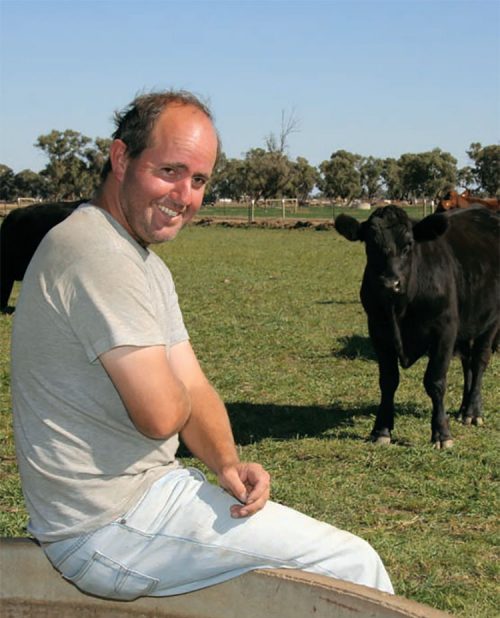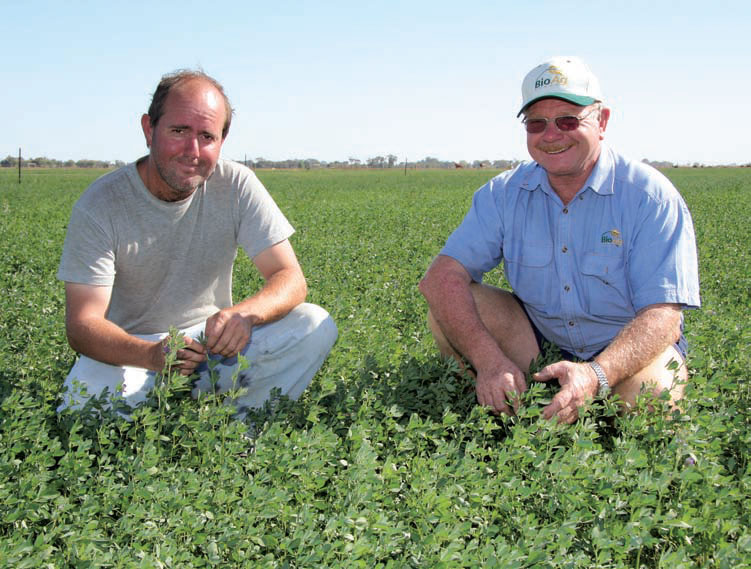
Case
Study
Location
Ballendella, Victoria
Crop
Pasture
Sobey Family, ‘The Castle’ Ballendella VIC
Adopting of biological farming principles has enabled north Victorian beef producer, Craig Sobey, to rejuvenate a run-down property to the point where it has almost doubled productivity in the past five years.
The Sobey family bought the Rochesterdistrict property, ‘The Castle’, in 1999, but it was not until late 2001 when Craig started to develop his dream of creating an organic beef enterprise that things started to change.
“Matters came to a head, so to speak, about two years ago when the pond began overflowing due to excessive rain.”

Craig Sobey, ‘The Castle’, Ballendella via Rochester, Victoria.
Craig, a fourth-generation farmer who trained as a cost engineer and spent most of his career in Asia, decided to apply science-based methodologies to his new farming enterprise.
“I was completely new to farming but it made sense to go forward with a biological or organic farming approach because it has sound, science-based principles behind it,” he said.
“You can add, subtract and change the outcomes, whereas a lot of conventional farming seems to be hammering a round peg into a square hole and hoping for the best. Soil tests might tell you an outcome, but they don’t really tell you anything about what’s actually making the soil work.”
Seeking to develop a biological farming program, Craig contacted Ivan Mitchell, the Deniliquin-based agent for BioAg.
Ivan developed a custom-made ‘fertility program’ incorporating a range of BioAg products, all of which are accredited organic inputs, in conjunction with conventional inputs in a bid to rejuvenate the compacted, barren alluvial clay soils.
The program included the application of large amounts of BioAgPhos® and lime, and smaller amounts of copper and zinc using a belt spreader. BioAgPhos is a reactive phosphate rock that has been treated with a proprietary microbial culture.
About half of its phosphorus content is available immediately for plant use, while the remainder is slowly digested by the microorganisms and added to the nutrient reservoir in the soil.
The improved soil microbial activity also unlocks phosphate, calcium and sulphur already in the soil, leading to long-term benefits in soil structure and fertility.
“We did the farm in five stages over a four year period,” Craig said. “Each autumn we ploughed up a new section, starting with our best soil and working our way to the poorer blocks, which required more investment.”
The program also includes the use of two fermented liquid cultures (BioAg Soil & Seed™ and BioAg Balance & Grow®), which deliver essential nutrients and metabolites directly to the crop, as well as stimulating microbial activity in the soil.
The two products have had a pronounced effect on Craig’s once-ailing lucerne pastures. “We had planted a lucerne variety early on that was later proven to be a complete dud,” Craig said. “It had poor germination and plant establishment, even though it was sown using conventional fertilisers. Three agronomists said it was a lost cause and advised us to plant something else instead.”
“We treated it with BioAg and after we had some rain it wouldn’t stop growing. That lucerne carried 150 cattle through winter each year while we sowed and developed the rest of the farm.”

Farmer, Craig Sobey and BioAg agent, Ivan Mitchell, inspect a vibrant stand of irrigated lucerne at ‘The Castle’, Ballendella via Rochester, Victoria.
Today, ‘The Castle’ supports 110 spring-calving Angus cows and a small herd of Angus, Hereford and composite steers, which are strip-grazed on 75ha of irrigated lucerne and clover-based pastures.
Craig believes the biological farming system has enabled his cattle to convert more of their feed into energy – meaning they do not have to eat as much and he can carry more per hectare – and improved their health.
Despite the drought and water restrictions, Craig not only grazed 150 head of cattle but also produced 150 tonnes of hay and silage. Between cuts he sprays the lucerne with BioAg Balance & Grow mixed with raw sugar to stimulate plant vigour and increase resilience to insect pests.
There has also been a notable improvement in soil structure, with the previously hard, lumpy soils now being soft and light. “We’re on our second lap around the farm with BioAg and we’re seeing improvements from year to year,” he said.
“The soil is a lot redder, very friable and is beautiful to work. It smells good! Earthworms and ladybirds have come back in huge numbers and we no longer have any problems with aphids or earth mites.”
Craig has begun cover sowing the whole farm with barley, a move he hopes will increase the level of soil organic matter and provide a welcome source of winter fodder for his beef cattle.
“The grazing process and the stubble will provide valuable food for the earthworms, while in turn, the worm castings become valuable liquid fertiliser when we irrigate,” he said.
“Craig believes the biological farming system has enabled his cattle to convert more of their feed into energy – meaning they do not have to eat as much and he can carry more per hectare – and improved their health.”
“It all leads me to believe that the soil and plants are humming along naturally and we’re on the right track in terms of productivity. Even in a drought we’re producing hay and feeding cattle.”
Craig and a number of like-minded farmers in the region have recently formed the Central Victorian Organic Network with assistance from Regional Development Victoria’s ‘Moving Forward’ program, the Department of Primary Industries and the Shire of Campaspe.
The network is seeking members from across the farming, processing and retail sectors. “I think there’s a huge future for biological and organic farming in Australia,” Craig said. “It could change the entire Australian agricultural landscape. Anyone with a long-term view of farming has got to seriously consider it.”
Download case study
Download a PDF version of the above case study.

Recent Comments